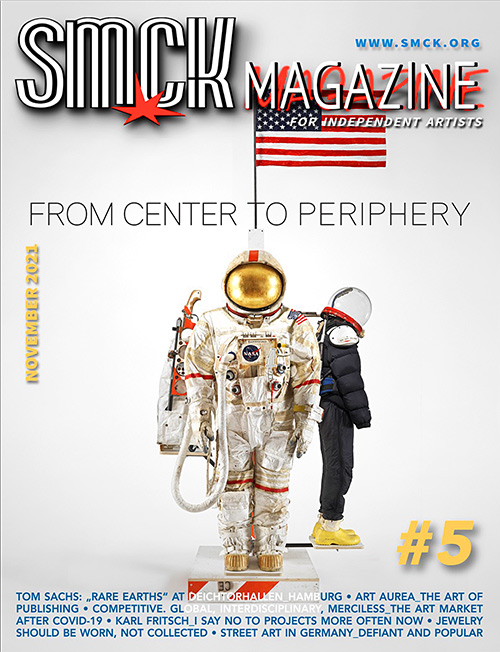IT'S THE ECONOMY, ARTIST!
MONEY - A TABOO TOPIC FOR MANY ARTISTS - BECAME THEIR MAJOR CONCERN AMID EVENT CANCELATIONS.
By Loukia Richards & Christoph Ziegler
 Anna Watson, „Dvarapala Brooch", 2020.
Anna Watson, „Dvarapala Brooch", 2020.DEMAND IS INCREASING
In a press release on 21 September 2021, Christie's CEO Guillaume Cerutti claimed the Covid-19 pandemic had not affected the auction house's revenues: "The art market has shown great resilience - auctions and private sales at Christie's have totaled US $3.5 billion in the first half of 2021, rivalling our best performances in the last decade."
The statement highlighted three interesting details: first, Christie's extensive use of digital tools and livestream auctions; second, the increased presence of Asian buyers, who accounted for 39 per cent of the total value of Christie's global sales; and third, the "huge influx of new collecting clients, 31 per cent of whom are millennials." Cerutti added: "We believe that the demand for artworks and luxury goods will remain aligned with the supply of high-quality objects and collections in the coming months, offering great opportunities for buyers and sellers."

Barbara Garcia, "Brooch To Monroe". A Girl's Best Friend Project, 2019. Brass, silver, steel, photo transfer, patina and brilliant-cut zirconia. Photo: B. Garcia.
Christie's auctions include Jewels Online, featuring status pieces signed by houses like Cartier, Tiffany, and Bulgari. Prospective buyers may purchase collectibles at prices starting in the lower four-digit figures. The news should give contemporary jewelry artists and galleries a reason to reflect upon their own price range.
While demand for art and design is increasing, the market is becoming more competitive. A broad range of choices from different art disciplines at affordable prices is available now. Quality, recognizability, future profitability, as well as the current risk of higher inflation - along with, of course, the prestige and pleasure stemming from collecting art - will continue to dictate buyers' choices.
EXPOSURE IS A SURVIVAL SKILL FOR ARTISTS AND GALLERISTS
Berlin-based gallerist Clemens Ritter von Wagner confirms the buying spree of exclusive, high-end jewelry art and believes that quality boosts salability. "It does not matter if quality refers to technical skills, the artist's concept to material used. I do not like mediocracy," he says.
Wagner also runs a virtual shop at the luxury platform 1st Dibs next to his downtown Berlin gallery. "This year I sold an item for a six-digit sum which I would never have imagined I would sell via the internet." His customers are affluent individuals. "Since Covid they have more money available that they cannot spend in any other way, such as travel, etc."
 Posters by HandShake project 'HSDCcolab', Melbourne 2021. Photo: Aphra Cheesman.
Posters by HandShake project 'HSDCcolab', Melbourne 2021. Photo: Aphra Cheesman.
New technologies, auction and e-shop apps, as well as online shows may work well for some artists, though not for everybody. Success in the online art business takes more than technology.
Poor sales during the pandemic were an experience many independent jewelry artists shared, especially those lacking a strong internet presence or a strong customer base before the pandemic.
The cancelation of art fairs - for some, major sources of revenue - was a blow for artists who did not or could not catch up with the online trend.
Geraldine Fenn, a jewelry artist and gallerist in Johannesburg, was motivated by the pandemic to reach out to the international public and intensify digital marketing. "We deal one-on-one with all our clients; we perhaps have more clients now who we communicate with remotely, but the essence of how we do things hasn't changed".
However, aside from more creative approaches than Zoom or video statements, often even something as simple as an old-school ad campaign can make a difference. HSDC Colab, a collaboration project between three initiatives - HandShake (New Zealand), Dialogue Collective (UK), and TempContemp (AU) - placed posters on Melbourne streets during Radiant Pavilion jewelry event hosted at venues across the city in September. "This worked well," says Peter Deckers, jewelry artist and HandShake's artistic director.
READ THE FULL ARTICLE IN THE DIGITAL OR PRINT VERSION...









